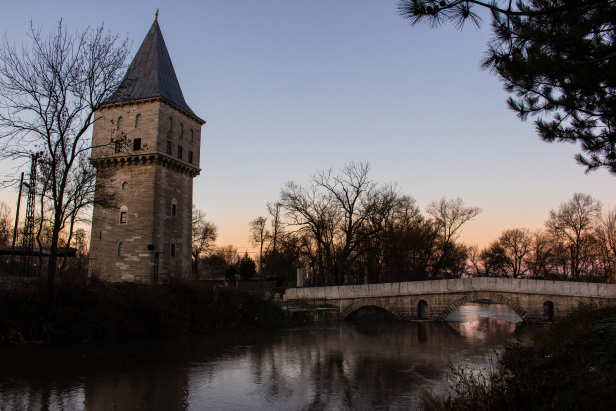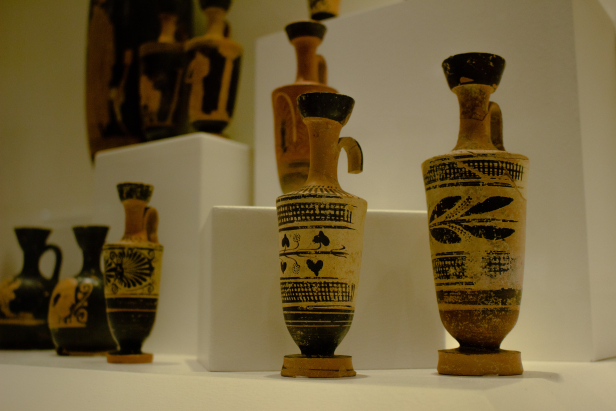The City of Edirne
/ By Josh
Formerly the Byzantine city of Adrianople, Edirne reached its zenith during the Ottoman period when it was, for a time, made the imperial capital. Even after the Ottoman court moved to Istanbul, Edirne remained one of the most important cities in the empire and continued to see money pour in for the grand buildings that made Edirne home to some of the Turkey’s most magnificent architecture. While Edirne is most famous for massive and ornate architecture it’s also home to one of the country’s largest and most unique festivals, fruit soaps, almond desserts, and fried liver.
Edirne is a small city of about 170,000 people, but due to its location on the Greek and Bulgarian borders and being the home of Trakya University it’s a relatively well off and lively city. Due to easy access from Europe and an abundance of sights Edirne also has a thriving tourism industry.
Subscribe to The Art of Wayfaring
Why Visit?
Selimiye Mosque
Cost: Free
Inscribed as a UNESCO World Heritage Site in 2011, Selimiye Mosque represents the apex of Ottoman architectural achievement. The Mosque complex is named for Sultan Selim II who commissioned the massive project only to die in 1574, a year before the project was completed. While the mosque is named after Selim it is more often associated with the architect Mimar Koca Sinan, whose statue is down the hill from Selimiye near Eski (Old) Mosque. With its unique design, lofty proportions, and a beautiful coherence to all its elements Selimiye is regularly considered the crowning masterpiece of Sinan’s illustrious career that includes hundreds of bridges, fortifications, fountains, mausoleums, palaces, aqueducts, and mosques. Never again was such scale and composition to be seen in the Ottoman Empire.

Selimiye Mosque follows the classical layout of a large, roughly square building topped by a single grand dome supported by a series of diminishing semi-domes and buttresses. One of the great innovations of Selimiye is to hide the square shape of the foundation by supporting the dome on eight pillars rather than four and placing semi-domes in the corners of the square. This allowed for two major changes. Firstly, some of the larger semi-domes could be stripped away from the drum allowing the main dome to stand more isolated above the rest of the structure. This meant that the mosque has an octagonal appearance rather than square. Secondly, with eight pillars rather than four they do not sit in the interior of the space but rather are incorporated in the exterior walls which keeps the room wide open and makes it feel much larger than other structures of this style. The dome itself is 31.28 metres wide, making it roughly the same size as the dome of the Hagia Sophia (though there seems to be much contradicting data about which is actually larger with no reason as to why).
The main structure of the mosque is flanked by a spacious courtyard surrounded by small domes with a fountain in the centre. Nearly all the major mosques built in this time had hoods, or roofs, added to the fountain in the courtyard. Selimiye is no exception but has had the good fortune of having the distracting roof removed which allows visitors to properly see the entrance from across the courtyard with the great domes stacked above.
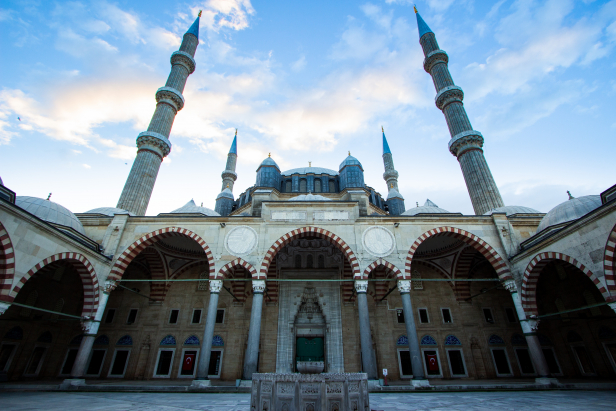
While the main attraction is certainly the mosque, Selimiye is actually a part of a larger social complex including graves, schools, soup kitchens, covered bazaar, bath, and time-keeper’s rooms. Many of these are still in use in their original functions though some have been made redundant by technology. One of the madrasahs now houses a museum of Islamic arts.
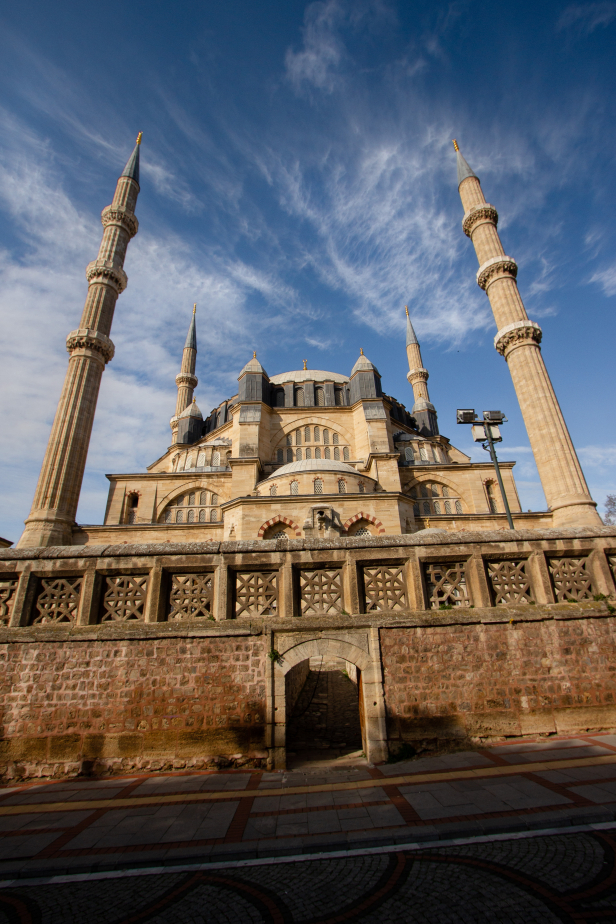
If you’re like me and would love to know more about the design and history of this mosque there are plenty of great books on the subject so I’m going to resist the temptation to continue on an architectural analysis! Let us know if you have any recommendations for us!
Üç Şerefeli Mosque
Cost: Free
Üç Şerefeli mosque is named for its least striking feature: one of its four minarets has Üç Şerefe, or three balconies.
Üç Şerefeli Mosque was built in 1447 by Sultan Murat II and is most noteworthy for its mismatched minarets. Three of these are beautifully ornate with patterns of red and white stone. The largest of these has the three namesake balconies and is absolutely massive. This minaret stands out clearly in the city skyline as the tallest and thickest. The mosque’s domes, both the grand interior domes and smaller exterior ones, are ornately decorated with flowing, colourful patterns.
Historic Markets
Cost: Free
In keeping with the historic significance of the city, there is a large number of ancient covered markets. Some of these are included in various mosque complexes, some were caravanserais, and some were independent bazaars. If you can’t handle the chaos of Istanbul’s Grand Bazaar then these offer a much quieter and less touristic option to experiencing these fascinating and often beautiful medieval shopping centres.

Bayezid II Complex and Museum of Health
2. Bayezid Daruşşifa ve Külliyesi
Cost: 15TL
Mosque complex entry is free; Medical Museum entry is 5TL
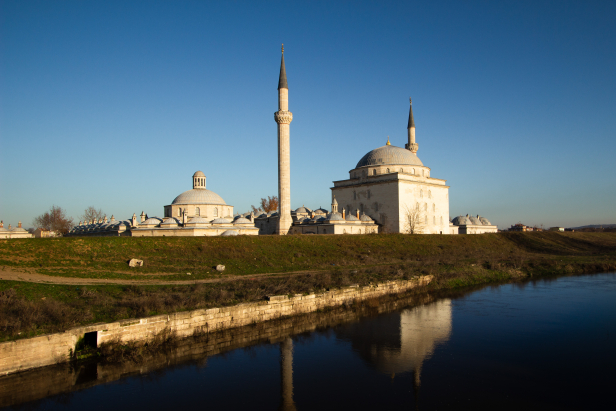
Set outside of the city on the west bank of the Tunca River, is a large complex built by Sultan Bayezid II in 1488 (in official documents the name is often written Bayezid though Beyazit is also common. If you know more about why that is let us know!). The old complex consisted of a hospital, a medical school, a mosque, soup kitchen, bridge, waterwheel, two baths, a mill, primary school, rehabilitation centre, a chamber for the imperial military band, and a building used by experts to set clocks and the time of prayers. Today all that is left is the bridge, mosque, hospital, medical school, and kitchens.
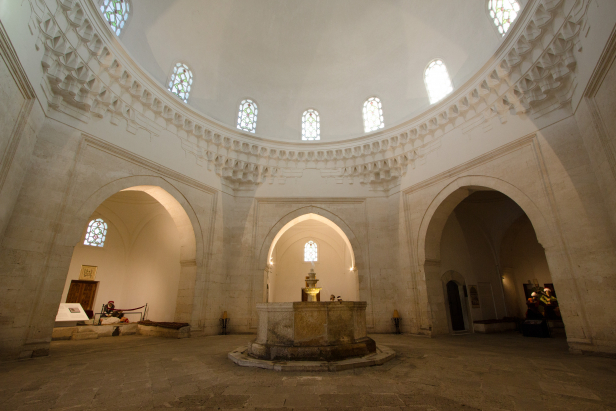
When you visit today the complex is divided into two parts: the mosque complex and a medical history museum.
The medical museum is run by the Trakya University Faculty of Medicine and is not only beautiful but a fascinating and thorough look at the history of medicine and hospice in the Ottoman Empire.
According to pictures from the 1950’s the complex in general was in a near-ruinous state though in recent years it has been magnificently restored with great care to stay true to the original design.

Old Mosque
Eski Camii
Cost: Free

Right in the centre of the city, just down the hill from Selimiye Mosque and across from the statue of Mimar Sinan is the oldest major building in Edirne to have survived intact until today. Built in 1414 in a simple near-square form of 9 large domes and fronted by a portico of five smaller domes, Edirne’s Old Mosque is architecturally simple. What ultimately sets this mosque apart is the exquisite, large scale calligraphy that decorates the walls and pillars.
You may also notice that the minarets don’t match and sit unevenly. This is because one was added at a much later date.

Kırkpınar Oil Wrestling Festival
Tarihi Kırkpınar Yağlı Güreşi Festivali
Cost: Subject to change
Prices will change from season to season. Other factors like seats or when you buy the ticket may affect the price.

Edirne is home to the historic Kirkpinar Oil Wrestling Festival, the longest running wrestling competition in the world. The tradition dates back to 1363 when 40 Turkish soldiers, apparently bored, began wrestling in the fields just north of Edirne. Two of the men wrestled through the night and in the morning died of the strain! They were buried near a fig tree and a spring later issued out from where the two men had been buried. The spot was named ‘Kırkpınar’ meaning ‘forty springs’ for the forty men and the spring that was there.
Today, matches are held in a stadium built for this purpose just to the north of the city as a part of a week-long festival in the end of June or beginning of July. Matches have a set time limit and contestants don’t die, though oil soaked wrestling in the summer sun may not be much better anyways.

Wrestlers wear special calf-hide pants with metal studs (they’re more capri length really) and are, most importantly, soaked in oil. Traditionally olive oil was used, though now you’ll notice that they’re actually using sunflower oil most of the time. The wrestling grounds will usually be full of wrestlers paired off and wrestling simultaneously making for a great sense of chaotic excitement. There are numerous classes of wrestlers from small children to the hulking men at the top of the chain.
For more about the rules and traditions of Turkish oil wrestling in Edirne:
http://aregem.kulturturizm.gov.tr/TR,132329/kirkpinar-oil-wrestling-festival.html
While tickets are sold at the event, there’s no guarantee that they’ll be available when you get there. To buy them online click here and search the event.

Bridges of Edirne
Cost: Free
The city of Edirne is built on top of a hill set in a bend of the Tunca river where it meets the Meriç, which keeps the fields green and adds beautifully to the scenery. With so much water surrounding the city it was important that numerous bridges be built over rivers and swampy lowlands. Many of these were built in the 1400’s and are still used by cars, trucks, and horses today.

The longest of the city’s bridges is Meriç (also known as Mecidiye) and is directly to the south of the city on the road to the Karaağaç neighbourhood. The riverside around this bridge is full of cafes that are bustling when the weather is good. Unfortunately, the banks of the river at this point have been reinforced with concrete walls and much of the natural beauty of this place has been lost, though it’s still one of the most popular hang outs in the city. At night it’s about the lights, the crowds, and the glowing bridge.
Justice Tower and the Ruins of the New Palace
Adalet Kasrı ve Edirne Saray Harabeleri
Cost: Free
Just beyond the Kırkpınar Oil Wrestling Stadium is a rather un-Ottoman looking tower and the foot of a small bridge called Fatih Bridge. This tower is quite Ottoman even if it doesn’t look it and was commissioned by Sultan Suleyman the Magnificent and designed by Mimar Sinan in 1561 to be used as a meeting place for the council of the Ottoman Empire. Unfortunately, the tower itself is closed to visitors though it is quite picturesque set at the foot of a small bridge on the riverbank.

Beyond the Justice Tower and over Fatih Bridge are the ruins of a 15th century palace built by Sultan Murat II. After the Ottoman Capital was moved from Edirne to Istanbul the palace fell into disuse and disrepair. Finally, much of the palace was blown up during the Russo-Turkish War (1870’s) when Turkish forces blew up a munitions depot near the palace to keep it from falling into the hands of the advancing Russian forces.
The cook houses, which are on the opposite side of the street near the river, have survived and there is also a small Turkish Bath that has recently been restored; otherwise there is very little remaining of the original complex. The ruins of the Felicity Gate and the Panoramic Pavilion are the most obvious ruins today.
Next to Fatih Bridge along the riverside is small Balkan War memorial.
Churches and Grand Synagogue of Edirne
Cost: Free
It can be a bit hit or miss when it comes to getting into these.

As a major city, Edirne gained a rather metropolitan flavour and was home to many Christians and Jews though few are left today. There are a number of churches and synagogues in the city; the most interesting of which is the recently restored Grand Synagogue of Edirne. At the turn of the century there were over 20,000 Sephardi Jews (in this case Jews expelled from Spain) in the city gathering in thirteen small synagogues around the city. Following the Great Fire of 1905, it was decided that one Grand Synagogue would be built to consolidate the thirteen others that had been destroyed. Over the following century the Jewish population shrank, and the synagogue was eventually abandoned and fell into considerable ruin. Restoration work began in 2010 and was completed in 2014.
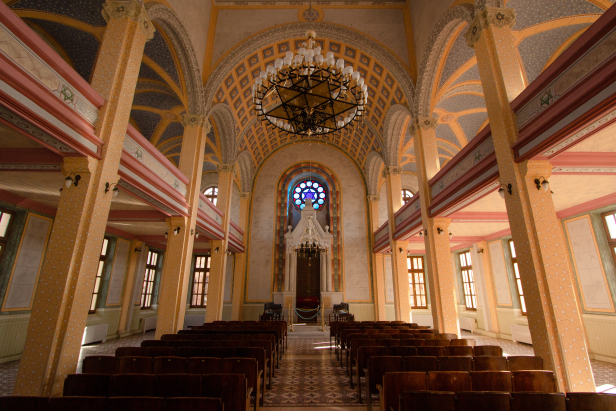
The Synagogue is not regularly active though services are held a few times a year.
Museums of Central Edirne
Cost: 5TL/Free
The archeology museum is 5TL and the Selimiye Museum is free.
While there are other museums on the outskirts of the city there are three main museums in central Edirne: Edirne Museum of Archeology and Ethnography, The Edirne Museum of Turkish and Islamic Arts, and The Kırkpınar Culture House.

The Edirne Archeology and Ethnography Museum is just to the north-east of Selimiye complex and houses a small though fine collection of artifacts from ancient times including early Thracian, Classical, Byzantine and Ottoman periods.
The ethnography section of the museum showcases life in Edirne during the Ottoman period and is one of the better small-city ethnography museums.
The Edirne Museum of Turkish and Islamic Arts is housed south-east of the Selimiye Mosque complex. Built as a Madrasah, or religious school, it now houses a collection of Islamic art and handcrafts such as tilework, traditional clothes, stonework, glasswork and more.
The Kırkpınar Culture House is a small museum honouring the Kırkpınar Oil Wrestling tradition where various memorabilia is housed.
Turkish Baths of Edirne
Hamamlar
Cost: Varies
Edirne is home to a number of the Ottoman Empire’s greatest monuments and structures. Turkish Bathhouses are no exception to this. While many of the historic baths have been lost to time and ruin there are still a number of grand bathhouses in operation today.

We went to Sokullu Turkish Bath just across from the Üç Şerefeli Mosque. Check out our in-depth review of Sokullu Turkish Bath.
Tower of Macedonia
Makedonya Külesi
Cost: Free
Behind Sokullu Turkish Bath is a rather out-of-place looking tower of stone and brick. This is known as the Macedonian Tower and is all that is left of the old city fortifications built by Roman Emperor Hadrian in the early 2nd century AD. Next to the tower you can see excavations of other pre-Ottoman structures though there’s no signage explaining what you’re looking at.
Others
Cost: varies
Here’s a few other sites we haven’t gotten to yet:
Karaağaç Neighborhood. This neighborhood is home to a beautiful old train station, old homes, and the Lausanne Monument built to commemorate the signing of the Lausanne treaty at the end of WWI and, especially, the establishment of the Republic of Turkey. The Karaağaç Neighborhood is 5km south-west from the city centre of Edirne.
Hıdır Baba Tabyaları A war museum just to the west of the city set in a large military bunker complex. Recently restored.
Balkan War Museum A war museum on the eastern edge of the city, set among Balkan War bunkers.
How To Get There
Bus
Coach buses run regularly from Istanbul to Edirne though there aren’t many options apart from one company. We were told they came into Edirne like a bus mafia and got rid of the other competition. Who knows? The bus terminal in Edirne is just a few kilometres from the city centre and is connected by city buses that take either a bus card or cash. For more about buses in Turkey…
Train
Though there is train service to Edirne from Istanbul the station is far from central. The station is called Halkalı and is by Küçükçekmece, a large lagoon a good ways west from the city centre potentially making it a less helpful option. Transit to the train station is mediocre though a taxi from anywhere near Ataturk Airport will be quick and cheap.
Car
Driving to Edirne from Istanbul is very straightforward as most highway signs in the city will use ‘Edirne’ to simply mean westward. It’s about a 250 km drive down the E80 toll highway or the slower D100.
If you’re coming from elsewhere in Anatolia and want to bypass Istanbul’s lovely traffic problems (but why would you?!) you can take the quieter route through Çanakkale and take the ferry at Çanakkale or Gelibolu (Gallipoli) then take the E87 highway north to Edirne.
For more about car rental and driving in Turkey make sure to read our full drivers guide.
Plane
Don’t try flying here. There’s no airport.
Where To Stay
Unlike many other Turkish cities of this size Edirne has a greater variety of accommodation options, many of which you can easily find online. As Edirne is on the main route from Europe into Turkey there are backpacker hostels, pensions, hotels, and some pretty grungy budget options as well.
Kaleiçi neighborhood has lots of affordable options and puts you right in the middle of everything you could want to see in the city. Many of the hotels and pensions here are historic buildings which, in some cases, means loads of character and in others that the walls are at risk of falling in. Your choice.
Have any tips or info to add? Spot any mistakes? We’d love to hear about it.






